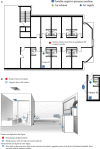Extensive Viable Middle East Respiratory Syndrome (MERS) Coronavirus Contamination in Air and Surrounding Environment in MERS Isolation Wards
- PMID: 27090992
- PMCID: PMC7108054
- DOI: 10.1093/cid/ciw239
Extensive Viable Middle East Respiratory Syndrome (MERS) Coronavirus Contamination in Air and Surrounding Environment in MERS Isolation Wards
Abstract
Background: The largest outbreak of Middle East respiratory syndrome coronavirus (MERS-CoV) outside the Middle East occurred in South Korea in 2015 and resulted in 186 laboratory-confirmed infections, including 36 (19%) deaths. Some hospitals were considered epicenters of infection and voluntarily shut down most of their operations after nearly half of all transmissions occurred in hospital settings. However, the ways that MERS-CoV is transmitted in healthcare settings are not well defined.
Methods: We explored the possible contribution of contaminated hospital air and surfaces to MERS transmission by collecting air and swabbing environmental surfaces in 2 hospitals treating MERS-CoV patients. The samples were tested by viral culture with reverse transcription polymerase chain reaction (RT-PCR) and immunofluorescence assay (IFA) using MERS-CoV Spike antibody, and electron microscopy (EM).
Results: The presence of MERS-CoV was confirmed by RT-PCR of viral cultures of 4 of 7 air samples from 2 patients' rooms, 1 patient's restroom, and 1 common corridor. In addition, MERS-CoV was detected in 15 of 68 surface swabs by viral cultures. IFA on the cultures of the air and swab samples revealed the presence of MERS-CoV. EM images also revealed intact particles of MERS-CoV in viral cultures of the air and swab samples.
Conclusions: These data provide experimental evidence for extensive viable MERS-CoV contamination of the air and surrounding materials in MERS outbreak units. Thus, our findings call for epidemiologic investigation of the possible scenarios for contact and airborne transmission, and raise concern regarding the adequacy of current infection control procedures.
Keywords: MERS; contamination; transmission.
© The Author 2016. Published by Oxford University Press for the Infectious Diseases Society of America. All rights reserved. For permissions, e-mail journals.permissions@oup.com.
Figures


Comment in
-
Reply to Kerkhove et al and Oh.Clin Infect Dis. 2016 Oct 15;63(8):1143-4. doi: 10.1093/cid/ciw480. Epub 2016 Jul 17. Clin Infect Dis. 2016. PMID: 27432837 No abstract available.
-
Transmissibility of Middle East Respiratory Syndrome by the Airborne Route.Clin Infect Dis. 2016 Oct 15;63(8):1143. doi: 10.1093/cid/ciw479. Epub 2016 Jul 17. Clin Infect Dis. 2016. PMID: 27432839 Free PMC article. No abstract available.
-
Interpreting Results From Environmental Contamination Studies of Middle East Respiratory Syndrome Coronavirus.Clin Infect Dis. 2016 Oct 15;63(8):1142. doi: 10.1093/cid/ciw478. Epub 2016 Jul 17. Clin Infect Dis. 2016. PMID: 27432840 Free PMC article. No abstract available.
References
-
- Centers for Disease Control and Prevention . MERS. Interim guidance for healthcare professionals . Available at : http://www.cdc.gov/coronavirus/mers/interim-guidance.html . Accessed 15 September 2015 .
Publication types
MeSH terms
LinkOut - more resources
Full Text Sources
Other Literature Sources
Miscellaneous

